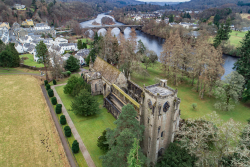 Without a roof to protect it, the stone of Dunkeld Cathedral is vulnerable to changing climate but specialist conservation team are working to protect it – from 1920 into Scotland’s Year of History, Heritage and Archaeology, as a blog from Historic Environment Scotland’s (HES) Duncan Ainslie explores.
Without a roof to protect it, the stone of Dunkeld Cathedral is vulnerable to changing climate but specialist conservation team are working to protect it – from 1920 into Scotland’s Year of History, Heritage and Archaeology, as a blog from Historic Environment Scotland’s (HES) Duncan Ainslie explores.
image Dunkeld Cathedral – HES website
Duncan writes:
Dunkeld Cathedral was one of the first buildings in Britain to receive government funded restoration. The state contributed towards the cost of repairs on several occasions. Some of the earliest government supported repairs date back to 1689, when the cathedral was damaged during the Battle of Dunkeld between Jacobite and Government forces.
The cathedral came into HES care in the 1920s, and we’ve been carrying out works to preserve it ever since. To ensure the stability of our monuments, we regularly carry out High Level Surveys. These involve using a range of equipment including: Mobile Elevated Work Platforms (like Cherry Pickers);Unmanned Air Vehicles (UAVs)
Scaffolding; And long reaching, remotely operated cameras to inspect parts of our monuments not easily seen from the ground.
At Dunkeld Cathedral, recent inspections highlighted a need for work on the wallheads, general walling masonry, and upper window tracery (some of the most important late medieval tracery in Scotland). Works are being carried out in several phases, focusing on one part of the cathedral at a time. First, scaffold was raised so we could undertake detailed inspection of the walls. This helped us work out where stones need to be replaced and joints repointed. Specialist conservation work will also be required for the delicate tracery.
We will also be erecting new hewing sheds for our Monument Conservation Unit stone masons. This means our masons will be able to work in-situ, and special tours to the site will allow visitors to see new stones being carved on site. This will promote the efforts that go into preserving these historic buildings, and highlight the often unseen but highly skilled labour we rely on to look after Scotland’s historic buildings. Our repairs will stabilise the cathedral stonework, ensuring it is protected for the future. Works to the wall-heads will protect the walls from water ingress, making them more resilient in the face of rainfall. These works will reduce the risk of loose high-level masonry and will allow us, in time, to fully re-open the cathedral to the public. The current phase of works began towards the end of 2014, and will continue in stages until 2021.
To know more about HES specialist conservation work, visit The Engine Shed, our brand new conservation hub in the heart of Stirling, which opens to the public on Monday 3 July 2017!
